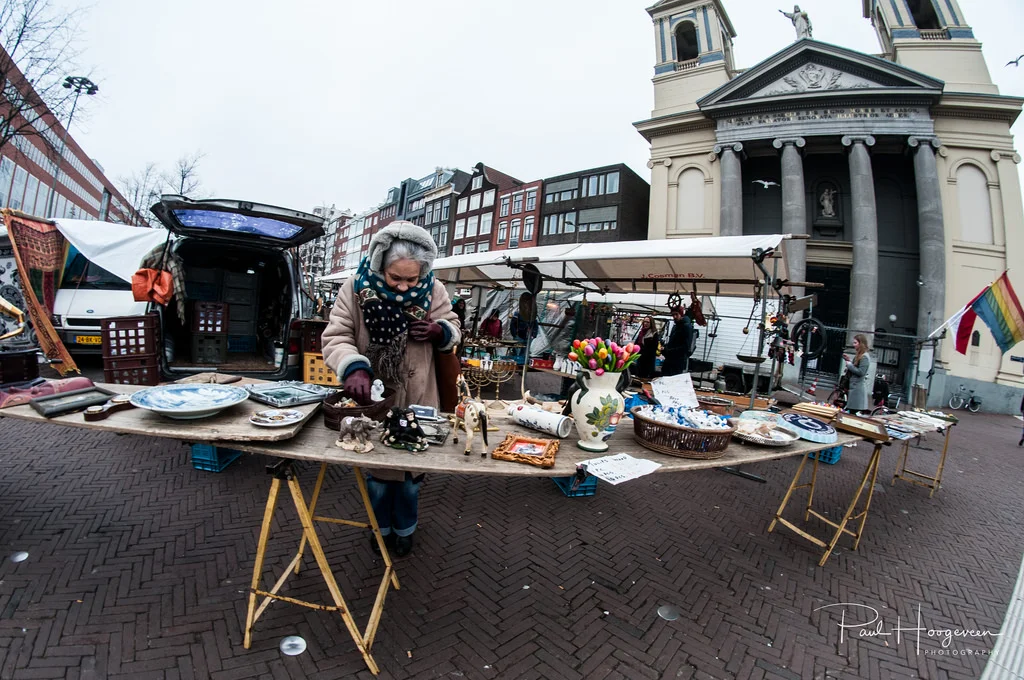Amsterdam
In Amsterdam, we were so fortunate to have the best tour guides, remember I mentioned the Jewish girls who lived on my grandmother’s farm during the war? Now 85 and 80 years old, spending time with them was a huge privilege. I explained that I wanted to make my setting ring true, and they were happy to give me the local’s tour. I’d written a scene where two of my characters take the train from the Centraal Station towards the Waterlooplein (a.k.a the old Jewish quarter) and I wanted to retrace those steps to see how far it was, to imagine the barriers, the smells, the vendors. Today it’s impossible to compare the black and white photographs to the current neighbourhood as much of the area has been torn down and rebuilt, but the Jewish Historical Museum helped to fill many of the gaps.
Then...
Now....Photo credit
Beyond setting, I was looking to inject local colour into the backstory of one of my characters. Imagine a young Jewish academic who distrusts the Joodse Raad voor Amsterdam and, rather than report, he changes his identity and heads east to seek shelter with an old friend, a jockey with a reputation for bending the rules. (In fact, about 2,000 people refused to register, with varying consequences.)
I wanted to see the kinds of buildings he would have seen, to imagine his home and family, his school. I wasn’t sure if he came from the older, more established Portuguese community or the newer Ashkenazi. Did he “look” Jewish? How far would he have to go to hide in plain sight? How many times would he have to change his identification? Was he a practicing Jew or was he so integrated into Dutch society religion hardly defined him at all?
The Historic Portuguese Synagogue, Amsterdam
I've seen Claude Lelouche's version of Les Miserables many, many times and continue to be inspired by the mash-up of Hugo's classic set in Nazi-occupied France. The character of Andre Ziman, portrayed by Michel Boujenah, continues to inspire my own character-building.
Camp Westerbork circa 1940
Westerbork
I’ve done a lot of reading about Camp Westerbork, so much in fact that my relatives joked that they thought I knew more about the Dutch transit camp than they did, which might be true. Although there were many visitors to the camp the day we went, it is not accessible to English speakers and looks nothing like it did in the 40’s, when it was only desolate wooden sheds on a heath. Today the barracks are gone but for one building that was used for decades as a barn by a local farmer. The heath has been swallowed up by forest and everywhere is the sound of birds. There is a large monument to all the victims who passed through the camp, but sadly it is very poorly maintained.
Westerbork now.
It was disheartening to see many stars missing from these bricks and the entire monument covered with dirt and gravel and organic debris. The Canadian cemetery in Holten, by contrast, is immaculate. I suppose it says something about how we feel about the victims of history and the heroes of history. I'm still ruminating on that one...
In June of 1939 the Dutch government passed a bill to loan 1.25 million guilders to the Jewish Refugee Committee to build Camp Westerbork, for the thousands of refugees seeking safety from anti-semitism in Germany and the east. When the camp was switched from Dutch control to German, barbed wire was erected and the railway line extended for future transport to concentration camps. A group fare, the Reichsbahn, was levied for these transports with funds sequestered from Jewish accounts. One of my aunts recently asked me why I was so obsessed with the past and my answer was that it all sounds to me a lot like asking the Mexicans to pay for a wall. I don’t know how the story ends for the parents and children separated at the U.S. border right now, but I can paint a picture of what has happened in the past, and remind people of the trauma that follows when we lose our humanity in these ways.
Close to S'heerenberg, near the German border
Huis Bergh
My maternal grandfather died when I was eight years old, but he was a storyteller and his tales of the Black Forest are imprinted on my mind even today. He had the gravelly voice of a chain-smoker and bright, animated eyes that lit up when the children in the story were in gravest danger. Of course I wanted to create a character who lived in a castle in the woods, but I didn’t even know if there were woods in the Netherlands, and if there were woods, were there castles? If there were castles and woods, who would live there and how would those people have responded to the occupation of the Nazis?
To those questions and more, I'm still searching for answers. It appears that many wealthy landowners, those in the highest class or, pillar, used their family fortunes and connections to go to England during the war. Some castles were used to house Nazi officers and supplies, others were used as hospitals and a handful were sealed off or sabotaged. I learned about the "witches" that were jailed in castle cellars, but that wasn't on my list of questions. Maybe the next book?
I still want to dig deeper to learn some personal stories about ways one might have maneuvered to hold on to their assets during the war. Certainly some manor houses passed from the aristocracy to shrewd businessmen during this period. (Those, for example who turned their enterprises into the service of the Wehrmacht.)
If you have expertise, anecdotes or recommended reading/ viewing on the topic of expropriation during the war, please get in touch.
Here's some of the WWII fiction on my shelf right now, and what I'm reading this summer. I welcome your recommendations.








